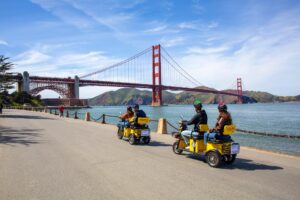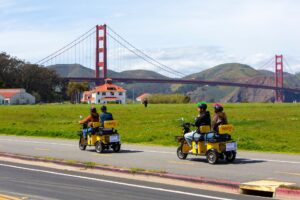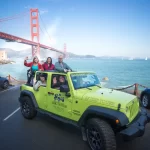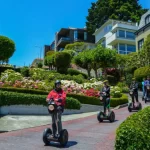Unveiling the Mechanics and Marvels of San Francisco’s Hyde Street Cable Car
San Francisco, the “City by the Bay,” boasts a unique charm that is deeply intertwined with its historic cable car system.
The Hyde Street Cable Car and its iconic Turnaround represent not only a mode of transportation but a living piece of history. In this comprehensive article, we’ll take an in-depth journey into the world of cable cars, Buckle up as we delve into the history of cable cars, explore the ins and outs of how they operate, provide essential tips for an enjoyable ride, guide you on ticket purchases, and uncover a dozen fascinating facts about these iconic vehicles.
Cable Cars: A Living Legacy
San Francisco’s cable car system is more than a means of getting around; it’s a testament to the city’s resilience and innovation. Let’s start by tracing the roots of this iconic mode of transportation.
Birth of the Cable Car: The cable car was born in San Francisco in 1873, thanks to the inventive mind of Andrew Smith Hallidie. Inspired by the struggle of horses on wet cobblestones, Hallidie devised a steam engine-powered cable-driven rail system.
Mining Origins: Hallidie’s family had a patent for “wire rope” cable in Great Britain, which he utilized in mining operations. This invention laid the groundwork for the cable car system.
Clay Street Hill Railroad: The first cable car line, the Clay Street Hill Railroad, opened in September 1873. It was an immediate success, kickstarting the cable car revolution.
The Great San Francisco Earthquake: A Test of Resilience
On April 18, 1906, the great San Francisco earthquake and the subsequent fires devastated the city. While cable cars survived, electric streetcars became more popular due to lower costs and wider accessibility.
The Electric Challenge: Electric streetcars, perfected by Frank Sprague in 1888, presented a more economical and versatile mode of transport. Cable cars faced stiff competition.
Cable Car Survival: Despite the rise of electric streetcars, cable cars held their own on the city’s steep hills. Some lines were rebuilt to cater to their unique abilities.
The Fight to Save Cable Cars
By 1947, Mayor Roger Lapham proposed phasing out cable cars due to the lower operational costs of buses. However, San Franciscans rallied to preserve this iconic mode of transportation.
Citizens’ Committee to Save the Cable Cars: In response to the threat of cable cars disappearing from San Francisco’s streets, Friedel Klussmann founded the Citizens’ Committee to Save the Cable Cars. They launched a public campaign to showcase the value of cable cars to the city.
Measure 10: The committee’s efforts culminated in Measure 10, which passed overwhelmingly in November. San Francisco had spoken: the cable cars were here to stay.
National Landmark Status
Today, San Francisco’s cable cars are not just a mode of transportation; they are a cherished part of the city’s heritage. They hold the distinction of being one of only two National Historic Streetcar Landmarks in operation in the United States.
National Historic Landmarks: San Francisco’s cable cars were recognized as National Historic Landmarks in 1964. Their continued operation is protected by San Francisco’s City Charter.
The Two Types of Cable Cars
San Francisco’s cable car fleet consists of two distinct types, each with its own characteristics and charm.
California Street Cable Car Line: This line features twelve larger, maroon cable cars with open seating sections at each end and a closed section in the middle. They can be operated from either end and use a simple switch to reverse direction at the end of the line.
Powell Street Lines (Powell-Hyde & Powell-Mason): These lines use smaller cable cars that can be operated from only one end. Turntables are used to reverse direction at the ends of the line. The roster typically includes 28 Powell cars, some sporting historic liveries that capture the cable cars’ appearance over their 12-decade history.
The Mechanics Behind the Magic
Now that we’ve explored the history and significance of San Francisco’s cable cars, it’s time to lift the curtain and uncover the fascinating mechanics that make them tick.
The Cable: At the heart of the cable car system is, of course, the cable itself. Andrew Hallidie’s invention of wire rope cable was a crucial element that allowed these cars to traverse San Francisco’s challenging terrain.
The Powerhouse: Each cable car line had its powerhouse, initially powered by steam engines and coal. These powerhouses generated the steam needed to produce power for the cable system.
Below the Street: The “Slot”: On the city’s streets, cable cars travel on steel tracks with a channel enclosing the cable. The grip on the cable car grabs the cable through a slot at the top of the channel.
The Grip: The grip mechanism is a critical component of cable cars. It allows the car to grab and release the moving cable, enabling controlled movement along the tracks.
The Brakes: Cable cars employ a combination of wheel brakes, track brakes, and an emergency brake to ensure safe operation and regulate speed.
The Cars: Cable cars have undergone several evolutionary changes since their inception in 1873. Today’s fleet includes 28 Powell Street cars and 12 California Street cars, maintained by the Municipal Railway (Muni).
Riding San Francisco’s Cable Cars
Now that you understand the history and mechanics, let’s get back to the fun part: riding the cable cars!
- Finding a Cable Car: San Francisco offers three cable car lines, with two starting at Powell and Market and heading to Fisherman’s Wharf, and one beginning at California and Market and heading to Van Ness Avenue.
- Cable Car Tips: Hold on tight, especially when navigating San Francisco’s steep hills. Be cautious when exiting, and always check for oncoming traffic. Remember, the green “X” traffic signal gives cable cars the right of way.
- No Bicycles Allowed: If you’re traveling with a bicycle, cable cars cannot accommodate them. Consider alternative Muni routes for bike-friendly transportation.
- Service Animals Welcome: Service animals are encouraged to ride on cable cars, either on their owner’s lap or as far out of the aisle as possible. When riding on exterior sections, service animals must be on their owner’s lap.
- Accessibility: Cable cars do not offer accessible boarding, so plan accordingly if you require accessibility accommodations.
Ticketing for Your Cable Car Adventure
Advance Fare Purchase: To board cable cars at Powell & Market, Bay & Taylor, and Hyde & Beach Streets between 8 a.m. and 5 p.m., it’s essential to purchase your fare in advance.
Pricing and Options: Cable car single-trip fares vary, so review pricing details to plan your journey. For extensive exploration, consider purchasing a visitor Passport for all-day travel.
The Cable Car Legacy Lives On
San Francisco’s cable cars are more than just a mode of transportation; they are a symbol of the city’s history, resilience, and charm. Whether you’re a curious traveler seeking adventure or a travel blog writer looking to capture the essence of San
Where to Find the Cable Car in Fisherman’s Wharf
Fisherman’s Wharf is served by two cable car lines: the Powell-Hyde line on Hyde and Beach Streets (Aquatic Park near Ghirardelli Square), and the Powell-Mason line on Taylor and Bay Streets (middle of Fisherman’s Wharf area, a few blocks from Pier 45 at Taylor and Bay Street).
Both lines run between Fisherman’s Wharf and Powell and Market Streets in Union Square. You can view a detailed schedule and route map of the Powell-Hyde cable car line here; the Powell-Mason cable car schedule and route map can be viewed here.
Ticketing for Your Cable Car Adventure
Buying Tickets
- To board cable cars at Powell & Market, Bay & Taylor and Hyde & Beach Streets, you must purchase your fare in advance (applies 8 a.m. to 5 p.m. daily).
- Pricing details for cable car single trips can be found here. For all-day travel, you may want to purchase a visitor Passport.
Other payment options:
- MuniMobile®: The SFMTA’s official ticketing app, MuniMobile lets you buy tickets instantly through a credit/debit card, PayPal account, Apple Pay or Google Pay.
- Clipper® Card: Clipper is the all-in-one transit card for the Bay Area. Use your Clipper card on all major Bay Area transit systems, including Muni.
- Cash: Exact change is required.
- Please visit Fares page for all cable car ticket details.
12 fun and intriguing facts about cable cars:
- World’s Last Manual Cable Car System: San Francisco’s cable car system is the world’s last manually operated cable car system. The grip operator controls the movement of the car and manually engages and disengages it from the moving cable.
- Maximum Speed: Cable cars typically travel at a speed of about 9.5 miles per hour (15.3 kilometers per hour). This leisurely pace allows passengers to enjoy the scenic views of San Francisco.
- Braking System: Cable cars have a unique braking system. The grip operator uses a large handbrake to slow down or stop the car, and wooden track brakes are also employed to regulate speed.
- Turntable Turnaround: To reverse the direction of cable cars at the end of a line, they use turntables. The Powell Street lines (Powell-Hyde & Powell-Mason) require turntables because the cars can only be operated from one end.
- Steep Hills: San Francisco’s cable cars are specially designed to navigate the city’s steep hills, some of which have gradients as steep as 21 percent. Their ability to climb these hills is one reason they are still in operation.
- Clang-Clang Sound: The distinctive “clang-clang” sound you hear when a cable car is in motion comes from a bell that alerts pedestrians and other traffic to the approaching vehicle.
- Historic Colors: The cable cars’ color schemes have historical significance. The maroon cable cars on the California Street line harken back to their original design, while the Powell Street cars sport liveries that reflect various periods in cable car history.
- Cable Car Bells: Grip operators use their bells not only for safety but also to communicate with each other. Different bell patterns signal different messages, like “stop” or “all clear.”
- Cable Strength: The cables used in the system are incredibly strong. Each cable is made up of numerous steel wires twisted together and can support the weight of multiple cable cars.
- Famous Movie Appearances: Cable cars have made appearances in numerous movies, including Alfred Hitchcock’s “Vertigo” and the 1906 disaster film “San Francisco.” They are often featured as iconic symbols of the city.
- Museum Dedicated to Cable Cars: San Francisco is home to the Cable Car Museum, located in the historic Washington-Mason cable car barn and powerhouse. It offers a fascinating look at the history and mechanics of cable cars.
- Limited Cable Car Routes: San Francisco’s cable car routes cover a relatively small area, primarily serving the downtown and Fisherman’s Wharf areas. They provide a unique and scenic way to explore these neighborhoods.
Catch a Glimpse of San Francisco’s Iconic Cable Cars on Hyde Street







